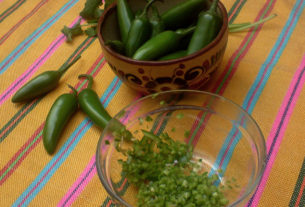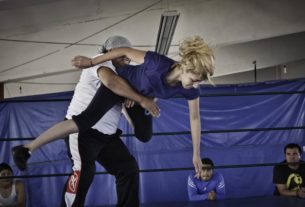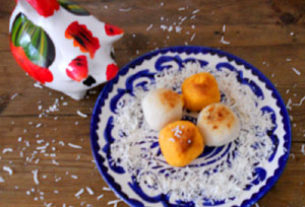Texas has the Alamo, New York has its Empire State Building, but only Michoacán has Pátzcuaro. Every travel poster extolling Michoacán has a shot of fisherman wielding the famous butterfly net. Look closely, and you’ll spy a tiny cone-shaped island, topped by a statue of José María Morelos, hand reaching to the sky. That’s Pátzcuaro’s jewel: Janitzio.
Just as some folks trek to the ski slopes or to the Jersey shore on a regular basis for spiritual renovation, I’m impelled towards Pátzcuaro for my spiritual fix. Even among the trite and cliché, there’s something magical and New Age in the air in Mexico’s version of Sedona at the edge of the high tropics.
Calming stillness nestled among buildings uniformly whitewashed and bordered in barn-red, signage fonted in a style regionally unique, red-tiled roofs and proud sense of decay make Pátzcuaro more than a historical preservation project.
Blame it on Thomas More and his Utopian vision. Or more properly, upon Bishop Vasco de Quiroga, a lawyer sent over from Spain back in 1532 to heal the ravages inflicted upon the peaceful locals by his fellow citizen Nuño de Guzmán. Ignoring mandates from his superiors in Morelia, Quiroga became the indigenous peoples’ advocate, encouraging the villages and burgs surrounding the lake to develop unique products to trade with one another, giving rise to a 16th century building boom that assured Pátzcuaro would reign as the capital of Tarascan culture.
Ethnically and linguistically distinct from other Mesoamerican peoples and successfully resisting Aztec domination, the Purepecha steadfastly maintain pockets of culture impermeable to Spanish influence. The Morelia daily newspaper La Voz publishes a Página Jimbo, entirely in Purepechan language, once a week. It’s impossible to decipher, despite a handy glossary. The atonal whine of Purepecha music evokes Andean flutes playing Bartok.
Pátzcuaro’s visitors run the gamut from middle class Mexican families to Europeans and Birkenstocked Americans. There’s nothing fancy here, not much nightlife, and exactly no pretense. And the most excitement might be yet another rendition of the Danza de Los Viejitos (Dance of the Old Men).
The town
Two plazas landmark downtown Pátzcuaro: Plaza Vasco de Quiroga (Plaza Grande) and Plaza Gertrudis Bocanegra (Plaza Chica). Entering from the main thoroughfare, the first plaza is Plaza Bocanegra. The main architectural attraction here is the Biblioteca, a former 16th-century church housing Juan O’Gorman murals in a quick primer of Michoacán and Tarascan history. Open Mon – Fri from 9-7 and Sat 9 am to 1.
A block away, the larger and better-manicured Plaza Vasco de Quiroga hosts the pricier hotels, stores and eateries.
Southwest of the Plaza Bocanegra is the tianguis, or marketplace. Although “market day” is officially Friday, the market is active every day, selling everything from fresh produce to woolens and machine parts. A few years ago, a tragic firestorm sparked by a gas tank explosion leveled the old market, but the stalls were resurrected in a more picturesque (and I wonder if equally flammable) ersatz Tarascan lath mockup.
The Casa de Once Patios (House of Eleven Patios), a nunnery in its original incarnation three hundred years ago, is the place for one-stop shopping for Michoacán arts-and-crafts-wares in a warren of tiny courtyards. Craftmaking demonstrations are an ongoing part of the show, but the better one is simply channeling back into time and imagining how good convent life just might have been. Only five of the original patios remain, but the hexagonal tiled bath is definitely worth seeing. Definitely not within ADA standards. Madrigal de las Altas Torres. 2 blocks from the Plaza Vasco de Quiroga. Open daily from 9 – 7 p.m.
El Museo de Artes Populares at the corner of Quiroga and Lerin, south of the basilica was formerly the old College of Saint Nicholas. This decaying old building houses a mind-boggling collection of regional handicrafts: local lacquer and pottery, Santa Clara del Cobre copper, traditional masks and religious objects made from pasta de caña, a cornhusk and orchid nectar paste. Enseñanza, at Alcantarillas. 1 block east of the Plaza Vasco de Quiroga. Tues-Sat, 9-7. Closed Monday.
Two steep blocks up from the Plaza Vasco de Quiroga is the Basilica de Nuestra Señora de la Salud (Virgin of Health), the jewel in Vasco de Quiroga’s crown. Banning holy images dressed in cloth in an effort to prevent the Purepechas from cloaking their own idols in Catholic vestments, Quiroga had the locals create religious images from pasta de cana. The Virgen de la Salud here doesn’t look particularly remarkable, but she’s supposed to having miraculous healing powers, if the Polaroid retablos bear reliable witness. If you’re in need of religious iconry or even a simple milagro, the vendors ringing the courtyard have something for every need.
Volcán del Estribo Grande (The Stirrup), about 4 km. from town is the vantage point for yet another killer-view of both city, lake and its islands. From the southwest corner of the Plaza Vasco de Quiroga, turn west on Ponce de León. This street turns in Terán, which then turns into Calle Paseo, and finally becomes Cerro del Estribo. This arduous climb makes San Francisco’s hills look like child’s play.
What to buy
Pátzcuaro is a shopper’s paradise. Handloomed textiles in wool, cotton and acrylic make great tablecloths. And don’t knock the acrylic: it’s genuine, washes well and will never wear out. Crocheted cotton and wool shawls. Hand-knitted sweaters. The much-touted Uruapan lacquer plates frankly are more than just a tad gaudy. Copper anything from nearby Santa Clara de Cobre. Wrought iron farolitos (lanterns), chandeliers, candelabra. Masks from Tocuaro. Straw wreaths, ornaments and doodads from Ihuatzio. Pottery everything in each village’s trademark glaze. Embroidery and cutwork from Erongaricuaro. Wood furniture and carvings from Pátzcuaro and all around.
Not surprisingly, new artesanía is always fascinating. Traditional appliques meet high fashion women’s clothing, time-honored wood carving techniques adorn compact disc storage units.
Within the past year, an artist’s mall and espresso bar have cropped up along southeast corner of Plaza Vasco de Quiroga. One shop sells only miniature tableaus of local scenes, another paper flowers. Upstairs is a South American nightclub, and just around the corner a bagel and scone shop sells freshly made zarzamora (boysenberry) jam and lime marmalade. Even though the bagels bore scant resemblance to Zabar’s, they were well worth the thrill — even without lox.
Getting there
By car from Morelia, Pátzcuaro’s a 60-kilometer drive along a newly completed four lane highway. The more scenic route, extending the trip to an hour’s journey, leads past Capula (great pottery town, but that’s another trek) and Quiroga, fighting traffic on a much more dangerous two-lane blacktop.
Six major bus lines leaving Morelia’s main bus station nearly every hour make the hour-long trip for about $2.
From Mexico City’s Terminal del Norte, buses leave hourly for the 7-hour trip; from Terminal Poniente (Observatorio), buses leave every 2 hours. The fares run about $15-20.
From Guadalajara, buses run make the 5-hour run somewhat less frequently for about $15.
The Central de Autobuses Pátzcuaro is about 1.5 km. south of the town center. City buses and collectivos shuttle into the city center every five minutes or so.
The closest airports are Morelia and Uruapan.
And for the truly adventurous, a second-class train runs between Pátzcuaro and Morelia daily, departing for the hour-long $.50 trip at 9:05 a.m. Another makes the 12-hour trip from Pátzcuaro to Mexico City, leaving at 9:30 p.m. The train station is about 3 km. from the center of town, between the muelle and the bus station.
Getting around
While the old town is best explored on foot, the Hotel Mansión Iturbide rents bikes for about $10 a day. Buses and colectivos marked “lago” make regular runs to the lake.
Victuals
Pescado blanco, unique to Lake Pátzcuaro, is prized throughout Mexico. This mild, almost-translucent skinned fish, called “white fish” even though it’s not the usual whitefish found elsewhere, was overharvested and later blighted by parasites, which left many just a tad leery about trying it. And true to the usual rule that many products are less glamorous at their source, most restaurants in and around Pátzcuaro fry pescado blanco to a fare-thee-well in plenty of oil. When ordering it, be sure to specify its mode of preparation.
Tiny smelt-like fish fried whole and served with lemon and chile, charales are often found in the deli areas of Mexican supermarkets, but in Pátzcuaro, you’ll have the best opportunity to taste these at the source. Many little loncherías fry these babies once in the morning and continue to refry them over and over throughout the day. The high calcium content compensates for the heavy grease.
Fish farms between Pátzcuaro and Uruapan assure a constant and reliable supply of trout, and salmon trout has given rise to a new local specialty — trout lox.
Lining the Plaza Bocanegra are street carts selling homestyle helados concocted from ingredients seldom associated with ice cream: pasta, avocado and corn. And don’t ask me why, but the very best palmiers on earth are in Pátzcuaro.
Like Garrison Keilor’s Lake Woebegone children, most restaurants facing the Plaza Vasco de Quiroga are all above average, wholesome, and frankly undistinguished except by decor. One restaurant in Pátzcuaro stands out among the rest: The Camino Real, adjacent to the Pemex Station about a kilometer north of town on the road to Morelia. The exterior looks, well, just like you might expect a Pemex restaurant would. Inside, the tablecloths, a nod to seasonal decor, and uniformed waiters begin to hint that this isn’t your everyday Pemex roadhouse. Several substantial comidas corridas make up the daily fare… as well as pescado blanco properly cooked to your specifications. Prices are reasonable, and it’s not unusual to find a crowd waiting outside. Open from breakfast through early evening.
Festivals
August 1-17. National Copper Fair. Santa Clara del Cobre.
21 October 97 to 2 November 97. Pátzcuaro Fair. A prelude to Day of the Dead, this artisan fair is an orgy of the best of the Purepechan Mesa’s wares from Paracho guitars and Tocuaro masks to furniture from Quiroga, assembled amid marigolds and orchids and guarded by the ever-watchful eyes of sugar candy skulls.
1-2 November of each year makes the Día de los Muertes (Day of the Dead) to celebrate the souls of loved ones. Traditionally, November first honors the souls of dead children, and the second, adults. Don’t even think about finding a lodging without advance reservations.
While Día de los Muertes is celebrated throughout Mexico, its heartbeat is in and around Pátzcuaro. Sightseers outnumbering and obscuring the mourners and the dearly departed mob Janitzio and Tzintzuntzan. Like Christmas, this holiday is more spectacular in its preparation and anticipation than in its climax. Spend your time instead enjoying the concerts, fireworks, and exhibitions that precede the night itself.
December 8 heralds Dáa de Nuestra Señora de Salud as the peregrinacíon (pilgrimage), parades, dancing, and art fairs usher in the Christmas season.
Easter Week Semana Santa, and particularly Jueves Santa, is heavily evented by the usual panoply of parades, exhibitions, and concerts.
What to wear
This is definitely Orvis and down vest country where fashion yields to comfortable sturdy shoes, jeans and longjohns. Year-round, it’s downright cold at night. A sunny afternoon in the 80s may see a temperature drop of 30 degrees within an hour. Believe me on this one — I once spent an April evening using a hair dryer for warmth!
Janitzio
Purely Purépecha, Janitzio is one of those places travellers either love or hate, but it’s always mandatory on my itinerary for out-of-town visitors. Fabled as a sovereign nation until the 1920s, undefeated and free of Mexican control, an adventurous local boy ventured to the metropolis of Mexico City, returned with promises of federal aid, and in one seemingly quick stroke brought annexation.
If I found myself reincarnated as Bill Gates, that’s where I’d make my dream home. Hmmmm… what would Microsoft be like if the Redmond operation fell victim to that giant sucking sound and landed along these inland shores?
A grand tour of the entire island might consume a leisurely hour with time to spare. The gewgaws – shellacked pine souvenirs, plaster of Paris mugs and plastic butterfly fishnets – are as authentically Purepecha as the Native American treasures stocked by every trading post on I-10 between El Paso and Tucson. During the past year the treacherous steps leading to the statute of José María Morelos have been improved, but you’ll still need the agility of a mountain goat to ascend to the top. (Bring small change if you do make the trek: my sister’s efforts were for naught when the tolltaker couldn’t make change.) Turn southward at the dock and wander the better-maintained and quieter paths leading past the locals’ homes.
Every restaurant on the island offers the same menu of chiles rellenos, arroz a la mexicana, and overfried fish. Stick with a simple bowl of Caldo Michi – a hearty tomato-based fish chowder.
Roundtrip launch boletos (tickets) are sold on the muelle (dock) for about $2, and the 30-person launches leave whenever the all the seats have been filled. The boats run daily from 8 to 5:30. During weekends and the tourist season, you may find a ragtag trio serenading you during the 20-minute cruise and an occasional helado or dulce vendor. If you’re lucky, the prevailing wind and current may prevent the captain from heading straight for the dock, and treat you to a cruise around the island’s backside where the three hundred or so island residents live.
The voyage to Janitzio means more than the destination. If you can, take an early or even mid-morning launch to the island, just to watch your fellow passengers toting 50-kilo sacks of produce and provisions homeward, to cajole one of the restaurants to serve you freshly fried charales, and to have the island to yourself.
Lake Pátzcuaro’s trademark butterfly nets seldom see action. In more than forty passages to the island, I’ve seen them in use exactly once. After carefully explaining to my Texan visitors before our cruise that the famed butterfly nets were now passe, Mexican serendipity brought us to Janitzio during the International Convention of Fireman…and sure enough, we were treated to the Ritual of the Butterfly Nets, complete with genuinely authentic plastic fish.
Janitzio is clearly not wheel-chair or baby-stroller accessible, and the step from the launch to the dock is definitely only for the fit.
Less developed but more accessible for the stroller-pushing crowd is the lesser-known Yunuen Island. Unlike Janitzio, where there are no overnight accomodations, Yunuen does have rustic cabins for rent..
At the embarcadero, longer trips around the lake to other islands, or even private boat con guide rental can be arranged. Stop by the taquilla (ticket office) or negotiate directly with one of the boatmen.
About a kilometer or two on the road to Tócuaro is a new dock, designed for the local folks, where parking is ample and the curio shops are less tacky.
Tzintzuntzan
Tzintzuntzan (sin-soon-son), the ancient Tarascan capital 18 km northeast of Patzcuaro, bears exploration.
A short kilometer from Tzintzuntzan proper, along the southern rim of Lake Pátzcuaro are the yacatas, enormous oval mounds bearing little resemblance to rigidly severe pyramids found elsewhere in the Republic. Restored only within the past decade, these awe-inspiring terraces were the heartbeat of the Purepecha kingdom when Vasco de Quiroga arrived. Wandering among this expanse and breathing the lake view, undeterred by guides, it’s very easy to fancy yourself among the priesthood. From the highway, the yacatas look unspectacular; only from within the compound do they seem to make any sense. Open daily 10-5, admission fee.
Craftsworks in Tzintzuntzan have declined in quality during the past decade. Originally known for black and white ceramics, construction of modern cement and brick vendor stalls has brought in a motley assortment of trinkets from hither and yon.
Better to stroll through the enormous Templo de San Francisco grounds, among olive trees planted by Vasco de Quiroga in defiance of the Spanish ban on New World olive cultivation, imagining the mass conversion of Tarascans. The Christmas church decorations in the two churches here are like none seen elsewhere: pine branches and two small Indian figures covered one church’s altar. The other church bore genuine birthday spirit with balloons, Christmas trees decorated with little hand-made garments for Baby Jesus, and — are you ready for this? Plastic bales of Pampers.
Wander through to yet another building and reach the taller, or workshop of Tzintzuntzan’s most famous scion: Manuel Morales. The son of the late Miguel Morales, who introduced the black-on-white traditional Tzintzuntzan pottery glaze in the ’20s when a faulty shipment brought the wrong colors, Manuel has taken traditional pottery to new heights. His designs marry traditional designs with matte glaze and fine detail not found among the offerings in the run-of-the-mill turismo shops. While most of Morales’ work is destined for galleries and pricier venues, the backroom of seconds harbor some great buys. Hours are unpredictable; when he’s not there, the place is closed.
And the town bearing the name of Don Vasco de Quiroga? Quiroga. Skip it.
Plan to spend at least a week in and around Pátzcuaro. Daytrips abound through the region. Santa Clara del Cobre (also called Villa Escalante), 20 kms. southwest, is to copper what Taxco is to silver. Amble over to Lake Zirahuen 12 km. south for a boat trip to the weekend-only French restaurant, to speculate on how soon lakeside ejido land will become a golf resort, or to check out the wooden spoon industry. Inspect Erongaricuaro, unchanged since Andre Breton’s day, at the westernmost edge of Lake Pátzcuaro for cotton fabrics and Steve Rosenthal’s fantasy furniture taller. Explore Tinagambato’s (30 km. towards Uruapan) rich archeological lodes.
And include a lazy day or so to sip café in the plaza, watching life pass by and wondering why you aren’t among the Deadheads who occasionally stroll into town.



